Text
I call upon the fan fic writing gods to bless you with the perseverance to finish one of your unfinished drafts.
May your fingers dance along the letters upon your device with ease, may the devil of distraction stay far from you, and may your work not need much editing.
I pass this blessing upon every fan fic writer out there.
137K notes
·
View notes
Text
How To Set Up An Ao3 Exchange
One of the first things I say whenever anyone asks me about running exchanges is that if you have more than about 30 people in the exchange, do NOT try to match it by hand. That is so much work and takes so much time. Use Ao3's matching algorithm. And people say sure, and then they look at how Ao3 works and they go uhhhhhhhhhh I think we can make a google form work. Because google forms are reasonably intuitive to make work, and Ao3 exchanges are— not.
But the thing is, once you understand the underlying logic for Ao3 collections, they are not that bad, and seriously I can't overstate the benefit of having Ao3 do the matching for you. That's like the difference between 80 hours of curating data as it comes in and then matching it, or 2 hours of double-checking the matching. You have to put in extra work to get an Ao3 exchange set up, but it super pays off in the end. So! Here is an intro to how Ao3 exchanges work on the back end. This explanation assumes you know how to sign up for an exchange because I've posted ones like that before, for example, here.
Let's get into it.
THE COLLECTION
The first thing you want to do is set up your exchange collection. If you go to your right-hand drop-down menu, you click on My Collections.

That brings you to every collection you have ever made, and you to to the right and click "New collection".

That brings you into the back end of the collection. You want to go down and put in a name for the collection that will be the url (so no spaces), a display name, an email for the collection to email when something happens to the collection (this will be public, so use a fandom email), and a basic description.

There's places there to do custom icons and headers, but those are optional, but you can go in and make your exchange pretty later if you want!
We are still in the "setting up" stage of the exchange, so once we go to preferences, you want to select all the tick boxes and make it look like this.

Moderated means that you'll have to manually approve things to be added to the collection (not absolutely necessary but can keep out trolls, and it also means that you can manually check that gifts meet minimums before you let them in to the exchange), Closed means that no one can submit things to the collection yet (once you open your exchange you de-select this), Unrevealed means that any works in the collection will show up as "mystery works" and not be readable (so you keep it unrevealed until the posting date, so people can post early but not spoil the surprise), anonymous means that all authors will be anonymous (this depends on if you have an anonymous portion of your exchange, so it's optional), "show random works" just means that you get a selection of different works when people visit the collection at different times, "send a message to the collection email" is optional but is useful for moderation (like if you're checking people off a list when their gifts get delivered), and "type of challenge" you want to be sent to "gift exchange".
and then on this page the only other things of concern are places where you can put in an FAQ, a description and some instructions, but those are all optional! I normally host the FAQ on tumblr, so I just say "go check the tumblr at [link]".
And then you hit the submit button.

Now we get into the nitty-gritty.

First up is some optional stuff— you can add in the times that you're going to do things! This is useful for communication, but not necessary. We're still setting everything up, so you do not want Sign-Ups to be open, that is only selected once you have everything ready to go.
Then scrolling down, you get to Requests and Offers.

This is where you specify the absolute minimum ships or characters that you want people to give you to sign up. 10 is the maximum Ao3 allows, so I always set it to 10 for both "allowed", which is the maximum the site will allow. And required is the low number. I usually set it to a minimum of three, to make sure someone doesn't sign up with "i will only write one ship" or something. This way, people will have to do a minimum of three separate requests and offers.
The "requests visible" is part of the back end thing, and it's up to you if you want to select it or not. If you keep it unselected, the only person who will be able to see requests is the mods, and eventually each person will see their assignment. If you select it, people will be able to browse everyone's requests and both maybe target offers so they can write for a specific person, and be able to find treats (extra bonus gifts) to write for people whose requests they like. Each side has its own benefits or negatives, it's up to you which ones you want to go with!
And here we get into more of the matching info! Let's look at Request Settings.
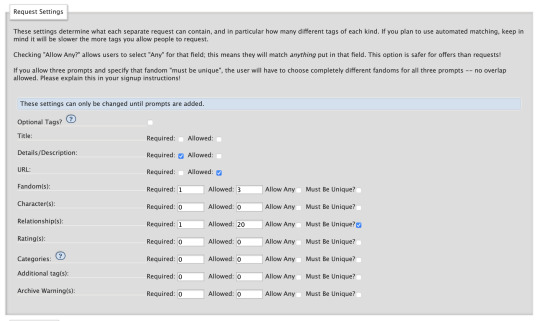
Now this is what the settings would look like for a multi-fandom exchange. The "details/description" box you want to make mandatory because that is where people will put their DNW and their prompts (and you absolutely want to make sure everyone has a DNW), and the url is an optional one which lets people link an off-site letter on google docs or dreamwidth.
Fandom allowing up to three fandoms means that people can do crossovers if they want (or tag a request something like 3rd life/hermitcraft), and if I wanted to say that people had to request 3 separate servers I would say "must be unique" but I'm okay if people sign up with three Dream SMP relationships in this idea hypothetical exchange, so I'm not selecting the unique button.
I'm ignoring the characters button cause that's extra complication, the only other thing I want to look at is the relationship button. A minimum of 1 ship per request (and there's a minimum of three requests), and let's say you can go up to 20, so people can request LOTS of different ships. I did select "must be unique" so someone can't sign up with the same ship three times. The "allow any" button is off, which means that I will have to select relationships that fit under the fandom that I selected one up, I can't request Shubble/Niki Nihachu (Origins), and put it with a fandom request for Hermitcraft. This has set it so that the absolutely minimum someone can sign up with is 3 relationships (3 requests * 1 relationship each), and the absolute maximum is 200 relationships (10 requests * 20 relationships each).

Requests will look much the same, except I am not putting down details/description or a URL, because I'm not letting people submit requests about what ship they "really" want to match on, they are going to be equally matchable to everyone they offered. Some exchanges will let you submit a requests DNW, but honestly that is so much extra work for the mods, I would not recommend it unless you think it's necessary to stop people from dropping their gifts later.
Okay, so now we take a brief digression into a tag set.
THE TAG SET
Okay so basically a tag set is an extra set of sliders that lets you fine-tune your exchange. If you do not use a tag set, when people sign up they will be able to use every canon tag on the archive, and only canon tags. Which is a LOT of tags, but when I ran an exchange without a tag set there were multiple times of hitting non-canon relationships or tags. But it's also a definite extra complication, tag sets are extra fiddly work and they are even less intituive. If you just want to go without a tag set, skip down to the matching segment. If you do want to avoid hitting people signing up with non-canon tags, keep reading.
I'm gonna say right off the bat that tag sets are the single most like "oh I am getting into the GUTS of the machine" part of running Ao3 exchanges, but if you can make them work they can super streamline both the sign-up (for your participants ) and the matching process (for you).

Oh boy, tag sets. Here we start getting into how exchanges start squeezing the interface to make it do what we want it to. I'm using a tag set, so first I clicked on the "tag set" url there and I made my tag set, and then I came back and selected its name from the drop-down menu on the collection. I leave all the tick boxes open, because selecting them will again restrict you to canon tags, and we specifically want to be open to noncanon tags both because of issues like "ijevin & tiny tim" not being a canon tag, and because the way MCYT tags are wrangled and made canon does not work for how the exchange machine reads information. We specifically want a collection of non-canon tags tuned for our needs. More on that later.
So, I started a new tag set, and I'm over there on that screen, looking at it. What does that screen look like?
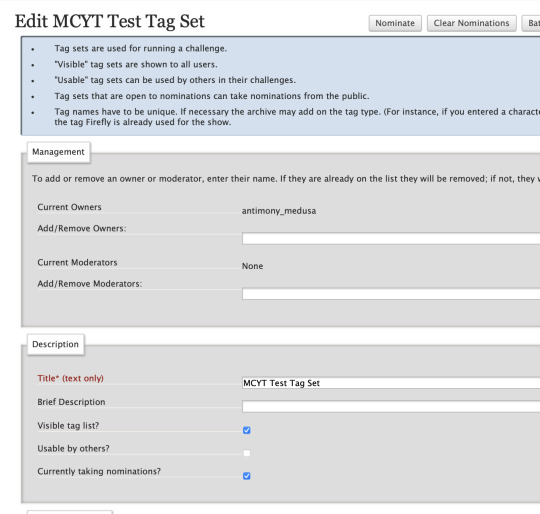
Okay so, part of the appeal of a tag set is that your participants are able to specify the difference between "Rendog & InTheLittleWood" and "Rendog/InTheLittleWood". You don't have to worry about people getting undesired shipping, because people were specifying if they wanted shipping when they signed up. You can reduce a great deal of people getting matched badly by using relationship matching, because most of the time even if people want a Tommy-centric fic, there's a pretty big difference between people who want "Tommy & Technoblade" and "Tommy & Dream". By specifying who you want the gift to be about, you remove a big hurdle of matching right away. That's why most exchanges run on relationship matching.
However, if there are 37 people on a given server, that's something like 2,600 possible combinations of people if you include both romantic and platonic, and that's before you start getting into trios, and that's just way too many tags for the mods to enter manually. So what you do is run a nomination period, and for a week or two weeks you go to all your participants and you go "do you want to sign up for this exchange? Nominate the tags you want to use now! If it doesn't get nominated, it can't be used!" And then people head to the tag set to nominate.
So, on this page, you want "visible tag list" to be selected, because you want people to see what's already been nominated so they don't duplicate, and you want "currently taking nominations" to be selected because you will be taking those nominations instead of doing them all yourself.
So you have to set up limits on those nominations.

The point of taking nominations is to make matching easier, so people normally use the same fandom and relationship limits as they are going to use on the sign-up, to make sure there aren't dozens of tags in the tag set that nobody's using, just cluttering up the space. It also helps stop the issue where someone sees a tag in the tag set, goes "oh man I love that ship" and signs up, but its an extra tag that no one intended to offer, so they don't match to anyone. That's why sometimes people keep the amount of tags that can be nominated low, I've seen people limit this to 10 tags, or even 7, so that's up to you.
And you save, and now when you link your participants the tag set, they will have a "nominate" button.

They will hurry over to press that button, and then they will see a page that looks like this.

This is a thing where you absolutely want to give your participants detailed instructions, because what Ao3 will try to do is auto-fill people's nominations with canonical tags. WE DO NOT WANT CANONICAL TAGS. CANONICAL TAGS ARE THE ENEMY OF EXCHANGES. CANONICAL TAGS ARE THE ENEMY OF MCYT EXCHANGES IN PARTICULAR.
Remember back when we clicked the button that says tags have to be unique? The canonical tag for Philza & Technoblade doesn't have a server on it, and people might want to be requesting that relationship for SMPEarth, Dream SMP, Origins SMP, or arguably even QSMP. If you only have the canonical tag, people can only request a specific dynamic once, for one server. And that is a problem for every situation where people interacted on multiple servers, and with the network of overlaps that is Empires/SOS/3rd Life/Hermitcraft and DSMP/Origins/SMPEarth/QSMP, that's going to lead to unhappy participants. So you tell people to nominate the ship and also "disambiguate" it, and add the server in parentheses. And then all your participants will hit the button to submit, and you will go into the "review nominations" button, and you will let those tags into the tag set.

Now I just distributed the tag set to a couple friends, so let's look at what this looks like behind the scenes.
Brace yourself, it's gonna be wild, but I believe we can get through it.

Now here is a perfectly standard look at tag set nominations after a few people have gotten into the tag set. This is why they pay tag mods the big bucks.
As you can see, there are a few things to be gathered. The first things is a bunch of people used the canon tags (because that's what Ao3 tries to get them to do), someone else nominated an x-reader ship, we have one tag there twice (spelled differently), and the tags are Piped (they have both the person's tax name and the username). (You can let tags in that are Piped, but I find that it makes the tag set harder to read, and usually exchanges are character-focused unless you're writing video blogging rpf anyways, so I ask people to submit tags unpiped, using usernames.) And for the tags that were nominated in a way that I want (unpiped, and disambiguated so they're unique), Ao3 is trying to get me to use the canon tag. But I don't want the canon tag, I want a unique tag, with the server on it, with no pipes. So.
So were I moderating the tag set, after a few minutes it would look like this.

That's going through and disambiguating the tags (adding the server, which I could tell because of the fandom it was nominated under), removing the piping and using the usernames instead of tax names, and then re-ordering the names so they're alphabetical so people can find them on the list later, rejecting the x-reader tag, rejecting the duplicate and allowing the one that's spelled correctly through. Amazing. I have tags that I want to use (I did some other tags that were ready to go in other fandoms as well). I hit submit. Am I ready to go?
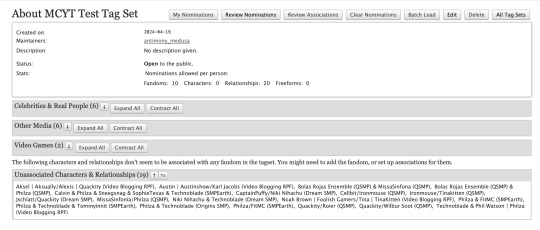
No, because tag sets are the most complicated part of exchanges.
I open up my tag set, and if I scroll down to "Unassociated characters and relationships" there are a bunch of tags that are are lost, Ao3 doesn't know where to put them. This is because we very carefully made unique tags that have not been wrangled anywhere, and Ao3 said "i don't know where these go" and shoved them all together in a garbage bin at the bottom of the page. So we have to manually go in to associate them to the right fandoms.
You hit the Edit button on the tag set, and scroll down to the bottom, to "tag associations", and start selecting where tags go.

Honestly this is a great time to be listening to a stream or a podcast or something, and then you have the tag set open in another tab so you know what all the unassociated tags are, and you just go down the list like a databasing machine. It is not hard, cause you disambiguated each tag with its own server, it's just time consuming. Note. This is why people go in and accept tags regularly during the nomination period, because if you do this all at the end you've got a BIG job ahead of you.
So, you turned on your VOD playlist and you associated all your tags, and all the tags are where they are supposed to go. You have a beautiful tag set.

But wait, you say, looking at this beautiful tag set. Some of those tags look at little different. What is the "Dream smp and only dream smp" that a couple of them have?
Well.
You see.
Ao3 designed tag sets to work a certain way, and nobody uses them that way. It turns out that "Quackity/Wilbur Soot (Dream SMP)" is a wrangled canon tag, and the system goes "ah, I know where this goes, this is a sub-tag of the major tag, and the top-level tag is Video Blogging RPF, so it goes under Video Blogging RPF, as all MCYT tags do. I am very smart. I have stuck this Dream SMP tag under Video Blogging RPF. I am a good machine". And then you go AUUUUUUUUGH, and then you turn up the podcast a little louder, and then you sit down and you delete the old tag and you write out a new tag that the system doesn't know what to do with, and it goes uhhhhhhh and sticks it in "unassociated tags" and then you go in again and you manually associate it into the right server.

It's not hard, it's just time consuming. Shouting at the tag set like STOP TELLING ME WHAT TO DO as it helpfully tries to stick dsmp tags in SMPearth and you wrestle it out of SMPEarth and into the right fandom bucket.
Deep breath moment. Honestly that's the most fiddly part of a fiddly process, so if you can get through this you're absolutely golden.
Anyways. You got clean disambiguated unique tags, and then you associated them in the right spot, and then you found the ones that got sorted to the wrong spot and you associated them yourself, and now you have a beautiful tag set ready to go. It's a thing of beauty. Shed a tear. Your participants can select from anything in this tag set, and you know they want to use these specific relationships, because they submitted them to you. What next?
THE MATCHING
Okay. You have your tag set set up and it's accepting nominations. Your participants are filling it out right now. You go back to your collection. it's time to tell it how to match.

This is the "minimum number to match" pane, and this is the minimum numbers to make a successful match. You want 1 for Fandom, and 1 for Relationship, and that's it. People will show up to the machine as a viable match as long as they have submitted a fandom and relationship that matches someone else's offered fandom and relationship.
This is a minimum viable exchange. You're ready to go. As soon as your tag set is done (or immediately if you're not using a tag set), you're ready to go back and open your exchange to sign-ups.
Congratulations!
FURTHER TWEAKING
HOWEVER. There is more that you can do. For example, do you want to allow people to request or opt into NSFW? There's an easy way to do that! First thing is you go back to your tag set, and you scroll down to the "ratings" section that you've been ignoring.

You select G and E, and that way, if people are opting into explicit that means they're okay with NSFW, and if they only select G, that means they only want a non-explicit piece.
Then on the collection you switch the requests and offers sections to include a place to specify a rating.
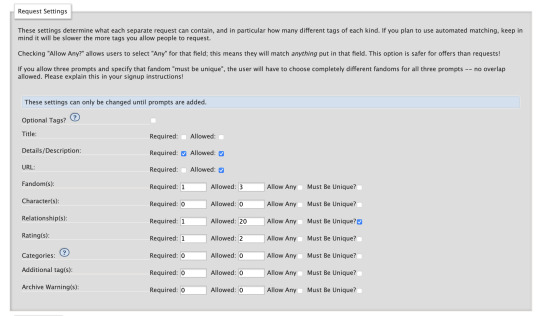
You want them to definitely specify at least one, and if you maximum allowed is 2, people can opt into both and say "i'm good with whatever"!
Then you scroll down to the matching section, and you tweak that to make sure that people will match on Fandom, Relationship, and at least one Rating.

Bingo. You now have a toggle to turn NSFW on and off.
But a lot of people like to match by TYPE of gift too, specifying if they want art or fic or playlist or web weave etc. How do you do that? Ah, at this point you are master of all you survey, and you can make tag sets do absolutely anything you want. You go back to the tag set and you scroll down to "characters".

Now we were matching on relationships, so the character box is unused. And it lets you put in your own tags. So what you do is you start to add in custom tags.

And then you go back to the Collection settings, and on the requests and the offers you go in to the "characters" section and you say "must select at least one, can select up to six".
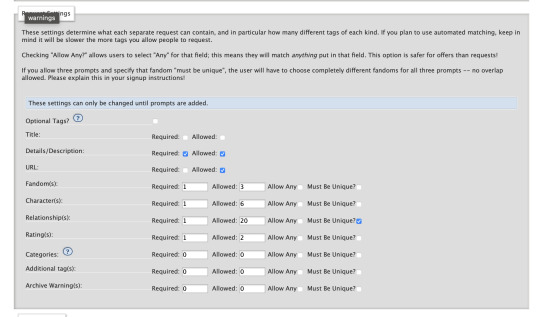
And then, you guessed it— you go back to "minimum number to match" and you set that "characters" tab to 1 minimum, 6 maximum. Now people who specified that they wanted Art can be matchable to artists who Offered Art. You have unlimited power, the world is at your fingertips.
There's even more customization that you can do, too! There's "additional tags", which is entirely custom tags you add yourself, that can be anything from specifying if people want fluff or horror or hurt/comfort etc— with the recursive exchange we used it to specify the works people were recursing— I'm considering using it for holidays with the holiday exchange. You can let people opt in or out of major archive warnings by selecting "archive warnings" as a thing that's in the tag set and that you're matching for. Once you understand how the underpinnings of how the machine works, you can wrestle it into almost any shape you want.
So. Whew. That's how exchanges work, under the hood. When I say that this is significantly easier than hand matching the holiday exchange, I ask you to picture just how complicated hand matching gets. Go forth! Thrive! Set up exchanges if you want! The world is your oyster!
Feel free to message me if you have further questions.
230 notes
·
View notes
Text


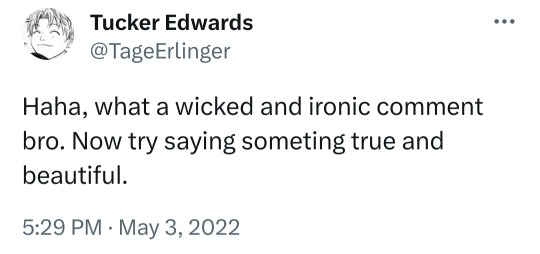



Certain words can change your brain forever and ever so you do have to be very careful about it.
372K notes
·
View notes
Text
Okay, here we go! This is currently listed as the final chapter for this bit, where it's shorter snippets for the group as a whole. It's possible that there might be more in the future, but it's not a promise.
Anyways, I've had this just in my wip folder for uh, literal years at this point, so I thought it was about time to just post it. There's also some outisder!POV of the first chapter of Desmond's story, which is my take on the first Assassin's Creed game in this sense8 fusion AU.
2 notes
·
View notes
Text
hot artists don't gatekeep
I've been resource gathering for YEARS so now I am going to share my dragons hoard
Floorplanner. Design and furnish a house for you to use for having a consistent background in your comic or anything! Free, you need an account, easy to use, and you can save multiple houses.
Comparing Heights. Input the heights of characters to see what the different is between them. Great for keeping consistency. Free.
Magma. Draw online with friends in real time. Great for practice or hanging out. Free, paid plan available, account preferred.
Smithsonian Open Access. Loads of free images. Free.
SketchDaily. Lots of pose references, massive library, is set on a timer so you can practice quick figure drawing. Free.
SculptGL. A sculpting tool which I am yet to master, but you should be able to make whatever 3d object you like with it. free.
Pexels. Free stock images. And the search engine is actually pretty good at pulling up what you want.
Figurosity. Great pose references, diverse body types, lots of "how to draw" videos directly on the site, the models are 3d and you can rotate the angle, but you can't make custom poses or edit body proportions. Free, account option, paid plans available.
Line of Action. More drawing references, this one also has a focus on expressions, hands/feet, animals, landscapes. Free.
Animal Photo. You pose a 3d skull model and select an animal species, and they give you a bunch of photo references for that animal at that angle. Super handy. Free.
Height Weight Chart. You ever see an OC listed as having a certain weight but then they look Wildly different than the number suggests? Well here's a site to avoid that! It shows real people at different weights and heights to give you a better idea of what these abstract numbers all look like. Free to use.
179K notes
·
View notes
Text
A research tip from a friendly neighborhood librarian!
I want to introduce you to the wonderful world of subject librarians and Libguides.
I’m sure it’s common knowledge that scholars and writers have academic specialties. The same is true for subject librarians! Most libraries use a tool called Libguides to amass and describe resources on a given topic, course, work, person, etc. (I use them for everything. All hail Libguides.) These resources can include: print and ebooks, databases, journals, full-text collections, films/video, leading scholars, data visualizations, recommended search terms, archival collections, digital collections, reliable web resources, oral histories, and professional organizations.
So, consider that somewhere out there in the world, there may be a librarian with a subject specialty on the topic you’re writing on, and this librarian may have made a libguide for it.
Are you writing about vampires?
Duquesne University has a guide on Dracula
University of Northern Iowa: Monsters and Religion
Fontbonne University has a particularly good one on Monsters, Ghosts, and Mysteries
Washington University in St. Louis: a course guide on Monsters and Strangeness
How about poverty?
Michigan State: Poverty and Inequality with great recommended terms and links to datasets
Notre Dame: a multimedia guide on Poverty Studies.
Do you need particular details about how medicine or hygiene was practiced in early 20th century America?
UNC Chapel Hill: Food and Nutrition through the 20th Century (with a whole section on race, gender, and class)
Brown University: Primary Sources for History of Health in the Americas
Duke University: Ad*Access, a digital collection of advertisements from the early 20th century, with a section on beauty and hygiene
You can learn about Japanese Imperial maps, the American West, controlled vocabularies, Crimes against art and art forgeries, anti-Catholicism, East European and Eurasian vernacular languages, geology, vaudeville, home improvement and repairs, big data, death and dying, and conspiracy theories.
Because you’re searching library collections, you won’t have access to all the content in the guides, and there will probably be some link rot (dead links), but you can still request resources through your own library with interlibrary loan, or even request that your library purchase the resources! Even without the possibility of full-text access, libguides can give you the words, works, people, sites, and collections to improve your research.
Search [your topic] + libguide and see what you get!
19K notes
·
View notes
Text
Pls reblog to spread and tell what specific word count in the tags!
6K notes
·
View notes
Text
So, through a series of events that include just talking with friends about it, I ended up talking myself into writing a SI fic where the SI is meant to go to a different world, but ends up crashing into SY on his way to transmigrating into SQQ, and the two of them end up sharing the same role. It's pretty self indulgent.
0 notes
Text
Ref Recs for Whump Writers
Violence: A Writer’s Guide: This is not about writing technique. It is an introduction to the world of violence. To the parts that people don’t understand. The parts that books and movies get wrong. Not just the mechanics, but how people who live in a violent world think and feel about what they do and what they see done.
Hurting Your Characters: HURTING YOUR CHARACTERS discusses the immediate effect of trauma on the body, its physiologic response, including the types of nerve fibers and the sensations they convey, and how injuries feel to the character. This book also presents a simplified overview of the expected recovery times for the injuries discussed in young, otherwise healthy individuals.
Body Trauma: A writer’s guide to wounds and injuries. Body Trauma explains what happens to body organs and bones maimed by accident or intent and the small window of opportunity for emergency treatment. Research what happens in a hospital operating room and the personnel who initiate treatment. Use these facts to bring added realism to your stories and novels.
10 B.S. Medical Tropes that Need to Die TODAY…and What to Do Instead: Written by a paramedic and writer with a decade of experience, 10 BS Medical Tropes covers exactly that: clichéd and inaccurate tropes that not only ruin books, they have the potential to hurt real people in the real world.
Maim Your Characters: How Injuries Work in Fiction: Increase Realism. Raise the Stakes. Tell Better Stories. Maim Your Characters is the definitive guide to using wounds and injuries to their greatest effect in your story. Learn not only the six critical parts of an injury plot, but more importantly, how to make sure that the injury you’re inflicting matters.
Blood on the Page: This handy resource is a must-have guide for writers whose characters live on the edge of danger. If you like easy-to-follow tools, expert opinions from someone with firsthand knowledge, and you don’t mind a bit of fictional bodily harm, then you’ll love Samantha Keel’s invaluable handbook
19K notes
·
View notes
Text
Terms You Might Want To Know For Your Wuxia/Xianxia Fic
MXTX's danmei are getting increasingly popular, and the fandoms are getting more fic-happy. I've noticed that some writers seem interested in writing their own fics but are concerned of making mistakes with niche honorifics and titles. I've noticed some that have jumped right in, but have made innocent errors that I'd like to correct but fear coming off as rude or presumptuous. And so I've made this list of terms that covers the basics and also some that are a little more niche since they're usually directly translated in cnovels.
DISCLAIMER: This is by no means a comprehensive list of everything one needs to know or would want to know concerning ancient Chinese honorifics and titles, merely what I myself consider useful to keep in mind.
Titles
Shifu: 'Martial father'; gender-neutral
Shizun: 'Martial father'; more formal than 'shifu'; gender-neutral
Shimu: ‘Martial mother’; wife of your martial teacher
Shiniang: ‘Martial mother’; wife of your martial teacher who is also a martial teacher
Shibo: elder apprentice-brother of your shifu; gender-neutral
Shishu: younger apprentice-brother of your shifu; gender-neutral
Shigu: apprentice-sister of your shifu
Shizhi: your martial nephew/niece
Shimei: younger female apprentice of the same generation as you
Shijie: elder female apprentice of the same generation as you
Shidi: younger male apprentice of the same generation as you
Shixiong: elder male apprentice of the same generation as you
Shige: elder male apprentice of the same generation as you, specifically one who has the same shifu as you or is the son of your shifu
Zhanglao: an elder of your sect
Zhangbei: a senior of your sect
Qianbei: a senior not of your sect
Wanbei: a junior not of your sect
Zongzhu: Address for a clan leader
Zhangmen: address for a sect leader
Daozhang: Daoist priests or simply a cultivator in general; gender-neutral
Daogu: Daoist priestess or a female cultivator; not as commonly used as 'daozhang'
Xiangu: Daoist priestess or a female cultivator; not as commonly used as 'daogu'
Sanren: a wandering cultivator
Xianren: 'Immortal Official'; a title of respect and power like 'General'
Xiuzhe: 'Cultivator', can be shortened to 'Xiu'
Xianjun: 'Immortal Master/Lord'
Xianshi: 'Immortal Master/Teacher'
Dashi: 'Great Teacher', address for monks
Xiansheng: Teacher/Sir; in ancient China, the connotation is very scholastic
Houye: address for a duke
Jueye: address for a noble lord, ei. a duke, marquess, earl, etc.
Wangye: address for king/imperial prince
Daren: address for imperial officials
Furen: Madam; the wife of an imperial official/nobleman OR a married woman granted a rank by the royal family
Nushi: Madam; the counterpart of 'xiansheng', connotation is scholastic
Taitai: Madam; address for an old married woman of the gentry, either wife or mother to head of household
Laoye: Old Lord; Address for an adult man with adult children of the gentry; possibly head of household
Nainai: Madam; Address for a married woman of the gentry, possibly wife of head of household
Ye: Lord; address for an adult man of the gentry, possibly head of household
Shaonainai: Young Madam; address for a woman married to a young man of the gentry
Shaoye: Young Lord; address for a young man or boy of the gentry, generation lower than head of household
Xiaoye: Little Lord; can be a synonym for ‘shaoye’ OR the son of a shaoye if ‘shaoye’ is already being used within the family
Xiaojie: Young Mistress; address for an unmarried woman or young girl of . . . the gentry and only the gentry, I believe. Correct me if you know for certain this is incorrect. (WARNING - It's an archaic term that should really only be used in an archaic setting if being used as a title instead of a suffix, because the modern vernacular has it as a term for a prostitute in mainland China. [Surname]-xiaojie is fine; Xiaojie by itself should be avoided.)
Gongzi: ‘Young Master/Lord/Sir'; ‘Childe’; young man from a household of the noble or gentry class
Guniang: 'Young Master/Lady/Miss'; ‘Maiden’; an unmarried woman or young girl from a household of the noble or gentry class
Laozhang: 'Old battle'; polite address for an unrelated old man of lower status than you
Laobo: polite address for an unrelated old man of a higher status that you
Laotou: 'Old man'; informal but not derogatory, implies fondness/closeness
Laopopo: 'Old woman'; informal but not derogatory, implies fondness/closeness
Please note that all of these listed above can be used as stand-alone titles or as suffixed honorifics.
Strictly Prefix/Suffix
-shi: 'Clan'; the suffix for a married woman, essentially means 'née'. (ex. Say Wei Wuxian was a woman and married into the Lan clan through a standard marriage. She would be called 'Wei-shi' by her husband's contemporaries and elders when not in a formal setting. It implies lack of closeness; used by acquaintances.)
a-: A prefix that shows affection or intimacy.
-er: A suffix that shows affection or intimacy; typically for children or those younger than you
-jun: 'Nobleman'; a suffix for a greatly respected man
-zun: 'Revered One'; a suffix for a greatly respected man
-ji: A suffix for a female friend
-bo: A suffix for an older man of your grandparents' generation
-po: A suffix for an older woman of your grandparents' generation
5K notes
·
View notes
Text
Works in Progress
A list of all works currently in progress. As long as it's not labeled as abandoned, it will be updated! Eventually!
simple souls - Assassin's Creed x sense8 fusion AU. Works: 2
Eight people across time and space meet, flying with wings that don't physically exist.
Sidestep - Assassin's Creed x My Hero Academia
Desmond saves the world, and ends up in a world of Heroes. Or something. He's mostly concerned about ending up an experiment. Again. Seriously, what was with his life?
Short Cuts - Cardcaptor Sakura x Lord of the Rings crossover
Sakura will hold out that it was an accident, and even if it wasn't, obviously there was some higher being at work. Still, she manages to travel sideways to Arda and finds herself joining the Fellowship of the Ring. Everything will definitely be alright! Right?
iris (when one pretends) - Bleach
Ichigo learned many things from Masaki- including the responsibility of being a Quincy. How to ask questions. That not knowing something was okay, but ignorance was something else entirely. And that family was what you made of it. This, of course, changes the trajectory of how Ichigo approaches most everyone and everything.
Demon Conqueror's Tragic Apostasy - Yin Yang Shi (Dream of Eternity), co written with americanjedi
Literature Professor Qingming wakes up in the child body of Qingming, the half-demon protagonist of Demon Conqueror's Tragic Apostasy. Luckily, this Qingming doesn't want to become the Fox Demon Emperor, as he would rather learn magic and recite poetry. Unluckily, it seems like the plot of the novel is correcting course. Can Qingming save the world from a great evil and the lives of everyone marked for death from the original plot?
1 note
·
View note
Text
@Fanfic writers:
My friend send me this link, is a series on a profile on Ao3 (tumblr) that has different tutorials to insert things to fanfics via html code, I thought I would share bc it’s really cool
Lists of tutorials:
How to make images fit in mobile browsers
This is a tutorial/live example on how to make large images fit on mobile browsers but remain normal size on desktop browsers.
How to mimic letters, fliers, and stationery without using images
This is a tutorial/live example on how to mimic the look of letters, fliers, and stationery (as well as other forms of written media) without using images. For all your epistolary fic needs.
How to make a “choose your own adventure” Fic
This is a tutorial/live example on how to create a "Choose Your Own Adventure" fic. While this has been explained before (see here), this particular tutorial shows you how to use a work skin to hide the next parts from the reader until they click through to get to them.
How to make linked footnotes on Ao3
This is a live example of how an author can create linked footnotes in their work with only a little bit of HTML and no workskins required. This is best viewed by clicking "Entire Work". While I've included the actual coding in bold and italic once you click "Hide Creator's Style", there's a more detailed explanation here.
How to change text on Ao3 when the cursor is hovering over it (or clicked on mobile)
This a tutorial/live example on how to have text change or appear once a cursor is hovering over it. Helpful for pop-up spoilers, language translations, quick author's notes, etc.
How to mimic author’s notes and Kudos/Comment buttons
Anonymous on tumblr: do you have a skin that would mimic the author’s notes and review/kudos buttons section from the end of a fic? the desired effect being that the fic could go on after the “end” of the fic, so after the author’s notes and review/kudos buttons
Here's a tutorial/live example to do just that, with some of the buttons actually functioning. I'll explain more inside!
How to wrap text around images
This is a tutorial/live example on how to align images to the left or right of the screen and have text wrap around them.
How to mimic email windows
This is a tutorial/live example on how to mimic email windows on AO3 without the need to use images.
How to make ios text messages on Ao3
This is a tutorial/live example on how to mimic iOS text messages on AO3 without the need to use images. There's also a chapter on how to have emojis displayed on AO3 as well.
How to make Customized page deviders
Bored with the default page dividers? This is a tutorial/live example on how customize your page dividers with no images needed (though I do show you how you could use images if you wanted to do such a thing).
How to make invisible text (That can be highlighted)
This is a live example how to make invisible text that can only be seen by highlighting the text. Tutorial is included in text, and you can always leave comments about questions you may have.
MOBILE USERS: Sadly, this probably won't work for you, since highlighting in a mobile browser is different than web. I've tried correcting this, but have yet to find a solution.
How to make a rounded playlist
Original coding and design is from layouttest. I make no claims for it, just tweaked it so it will work on AO3.
How to create notebook lined paper on Ao3
This is a live example of my AO3 skin that allows the author to recreate the look of lined notebook paper in their work. To learn more about it, you can find the tutorial here.
Sticky notes on Ao3 without using images
This is a live example of my AO3 skin that allows the author to recreate the look of sticky notes (aka Post-Its) in their fic. To learn more about it, you can find the tutorial here.
How to make deadpool’s thinking thinking boxes on Ao3
This is a live example of my AO3 skin that allows the author to recreate the look of Deadpool's thinking boxes in their fic. To learn more about it, you can find the tutorial here.
How to make newspaper articles on Ao3
This is a live example of my AO3 skin that allows the author to recreate the look of a newspaper article in their work. To learn more about it, you can find the tutorial here.
33K notes
·
View notes
Note
I have a friend who is doing freelace editing. She charges 0.03 per word, before tax. My book is 100000 words (or around), and she told me that the price for her editing would be 3,075 dollars. She told me this was on the low end of editing, is that true? I'm okay with doing my best to edit my own book (which I am I'd just like a second pair of eyes if possible.) But 3,000 dollars is not within my pay range. (Thanked her for going over the prices with me and told her I was sorry I couldn't.)
How Much Does Editing Normally Cost?
Hi there! It really depends on the kind of editing, how experienced (and busy) the editor is, the shape the manuscript is in, and a number of other factors. I’ve seen anything from .005/word for proofreading to .08/word for developmental editing. My own rates start at .015/word for an editorial review and go up to .03/word for a heavy developmental edit (consult + lengthy critique + margin comments + follow up call + email support).
A lot of people experience sticker shock with editing, so you’re not alone there. You can find people to do it for cheap, but it’s usually a you-get-what-you-pay-for kind of thing. (At the same time, I always encourage writers to ask editors for a sample of their work before hiring them–don’t assume that because the editor charges a lot you’ll click with their style.)
I might be preaching to the choir here, but I’ve gotten enough asks about editing prices that I think it’s worth pointing out a few things:
Editing takes time. You can’t just quickly breeze through a manuscript once and come back with helpful, detailed recommendations. In my case, no matter what kind of editing I do, I carefully read every manuscript twice. Because of the level of focus and attention I give to the story, for a 100,000 word manuscript that could mean almost 20 hours of my time just to read the thing… before I even start writing a critique.
Good editors are experienced and often highly educated. If you can find an editor who is willing to work for minimum wage, more power to you (I guess?). Personally, I’m a published fiction writer, and I have a masters degree and years of experience in my field, so I charge accordingly. Most editors I respect (read: that I would hire myself) have rates starting at $80/hr.
If you want useful feedback, there’s no such thing as “taking a quick look” at your manuscript. I get a lot of inquiries from writers who hope I can come down on my price if they don’t need as much feedback: “Just take a quick look” or “give me an overall impression.” There are two problems with this. The first (see above) is that even reading the manuscript can take hours of my time. The second is that the only way for me to give “quick” feedback is to give shallow, crappy feedback… which I just can’t bring myself to do.
The bummer, of course, is that all of these factors put editing way outside of a lot of writers’ price range. Every time I get an inquiry from a broke writer and have to turn them down, my heart dies a little. That’s part of the reason I’m working on my self-editing guide The Complete Guide to Self Editing for Fiction Writers. It’s a DIY guide that walks you through doing a story-level, scene-level, and sentence-level edit on your story. Completing it has been slower going than I originally thought (It just keeps getting longer!!), but I hope to have it finished soon.
Thanks for writing! I hope this has been helpful, and good luck to you!
//////////////
The Literary Architect is a writing advice blog run by me, Bucket Siler. For more writing help, check out my Free Resource Library, peruse my Tumblr Post Guide, or get The Complete Guide to Self-Editing for Fiction Writers. xoxo
4K notes
·
View notes
Text
magic system where “dark magic” and “light magic” are literal terms - dark magic consumes photons, making an area around the spell visibly darker, sometimes to an Extreme extent, and light magic releases photons.
because of this most dark mages tend to work in very brightly-lit areas (either artificial light or outside in the daytime) to fuel their spells and wear and use lightly coloured clothes and tools so that they’re easier to see in the dimness their spells create, whereas light mages wear heavy, sometimes leaden robes (depending on the work being done) and the magical equivalent of welding masks to protect themselves from what can be an extreme amount of light, and sometimes other kinds of electromagnet radiation!
needless to say this is incredibly confusing for anyone unfamiliar with the culture
48K notes
·
View notes
Text

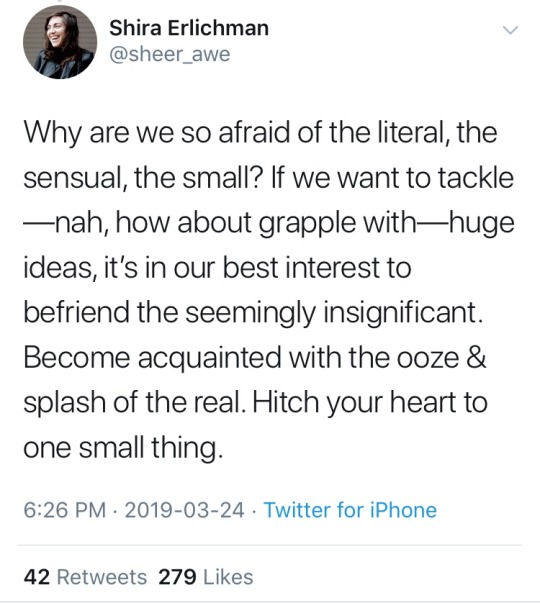
hitch your heart to one small thing
127K notes
·
View notes

